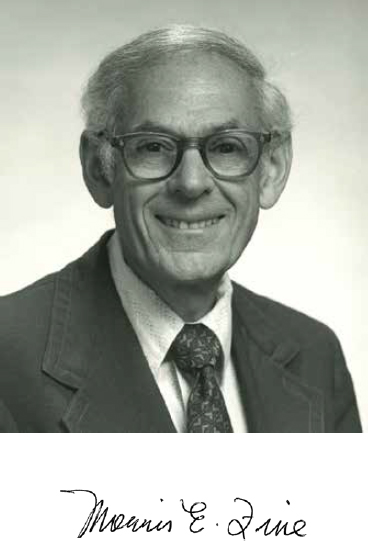This page intentionally left blank.

MORRIS E. FINE
1918–2015
Elected in 1973
“Contributions to education, research and development in the field of materials science and metallurgical engineering.”
MORRIS EUGENE FINE, Walter P. Murphy Professor Emeritus and Technological Institute Professor Emeritus of Materials Science and Engineering at Northwestern University, passed away peacefully in his home on October 1, 2015, at age 97. He was born April 12, 1918, to Louis and Sophie Fine in Jamestown, North Dakota.
He said his studies of materials began in the spring of 1936 with a University of Minnesota course in geology that included some mineralogy. He completed all his degrees there: a BS in metallurgical engineering (1940) and an MS (1942) and PhD (1943) in physical metallurgy. Even as his interests expanded well beyond metals—everything from physical chemistry to mechanical behavior in alloys, ceramics, and composite materials—physical metallurgy and phase transformations remained central.
A member of the Northwestern University faculty since 1954, he was a globally recognized leader in the field of materials science and cofounder of the world’s first materials science department. He came to Northwestern with experiences that included work with Cyril Stanley Smith on the Manhattan Project in Chicago and Los Alamos, followed by research at the historic Bell Labs in Holmdel, New Jersey. He was interviewed at the latter by lab legends James Fisk and William
Shockley and attributed their interest in him to the fact that he had studied solid state physics as well as metallurgy.
He cofounded Northwestern’s Department of Metallurgy and was its first chair. Influenced by Smith’s generalist thinking, he and his colleagues saw the potential of applying the principles of materials microstructure established in physical metallurgy across all classes of materials, grounded in the theory of first-order phase transformations. Accordingly, the department broadened its scope to include the study of ceramics, polymers, and electronic materials, unified by a microstructure-based approach. The new profile inspired a new name, the Department of Materials Science, in 1958.
Fine also brought to Northwestern one of the first three interdisciplinary laboratories funded by the Department of Defense Advanced Research Projects Agency (ARPA). As the lab’s first director he established a strong culture of collaborative multidisciplinary materials research and education. This culture was soon embraced by other universities, and it remains at the core of Northwestern’s Materials Science and Engineering Department and its other materials research efforts.
During a period when novelty-seeking agencies pulled materials research to its periphery at the expense of its core, Fine, supported by Jerry Cohen as dean of engineering, remained committed to investment in leading metals faculty. They created a strong position in steel research, fostered by Fine’s directorship of the Steel Resource Center, founded in 1987 and funded by the American Iron and Steel Institute.
Fine believed in “Pasteur’s Quadrant” of research that is both fundamental and useful. Northwestern’s balanced materials research portfolio, with its well-established metallic materials component fostered by Fine, enabled leadership in the science-based materials engineering known today as the materials genome.
Although required to retire in 1988 by age limitation laws in force at the time, Fine remained an active member of the community until his final days. He inspired his colleagues by coming to work nearly every day and continuing to write proposals and publish his research, resulting in more than 300
papers to his credit. Early in his career his book Introduction to Phase Transformations in Condensed Systems (Macmillan, 1964) was broadly adopted as a textbook for principles of microstructure development in undergraduate materials curricula around the world.
In his 1996 Institute of Metals/Robert Franklin Mehl Award Lecture, he discussed industrial applications of phase transformations, providing examples of research results that might be useful to industry. He underscored the importance of making relationships between universities and industry more productive for both.
Collaboration with the local steel industry led to successful application of his copper-strengthened “NUCu” structural steels. These steels, which exploit nanoscale copper precipitation hardening to combine corrosion resistance with high weldability, have been taken all the way to bridge construction applications in Illinois. Based on his successful transfer of basic research results to practical use, Fine was awarded the 2009 Application to Practice Award by the Minerals, Metals, and Materials Society (TMS)—for research conducted in his 90s.
He enjoyed an extensive list of honors. He was selected for the ASM International Gold Medal (1986); TMS Educator Award (1993) and 1996 Institute of Metals/Robert Franklin Mehl Award and Lecture; and Champion H. Mathewson Award (1981) and James Douglas Gold Medal (1982) from the American Institute of Mining, Metallurgical, and Petroleum Engineers (AIME). In addition to the NAE, he was a member or fellow of the American Academy of Arts and Sciences, American Association for the Advancement of Science, American Ceramic Society (ACerS), American Physical Society (APS), ASM International, and TMS, as well as an honorary member of AIME and the Japan Institute of Metals.
In 2009 the Department of Materials Science and Engineering at Northwestern created the Morris E. Fine Lecture to celebrate his life and contributions. And at a 2013 TMS symposium honoring his 95th birthday, he was acknowledged as the true “Father of Materials Science.”
But of all his life’s professional successes, he experienced the most pride in the students he advised throughout his career. A celebration of his 90th birthday allowed graduate student number 1 to meet number 76.
Fine will be remembered as an inspiring mentor, selfless collaborator, and valued friend. He was known for his patience, inventiveness, and excitement for new ideas. He played doubles tennis into his 90s and was an avid music lover who appreciated classical, jazz, and opera.
He was devoted to his family: his wife of 54 years, Mildred (née Glazer), who predeceased him in 2004; daughters Susan Fine and Amy (Andrew) Tiedemann; and granddaughters Lauren and Jennifer Tiedemann.






